Scanning Around With Gene: Everybody Polka!
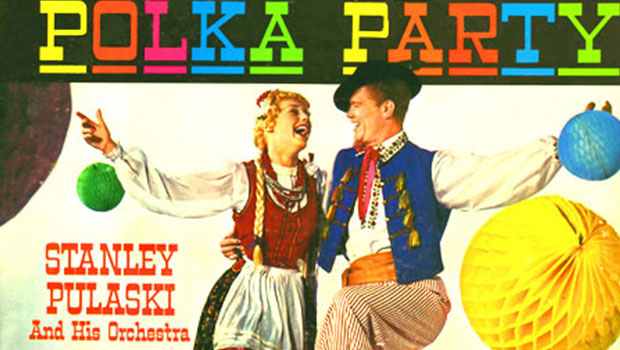
At last month’s Grammy Awards, a milestone was reached that very few noticed. Jimmy Stur, the current American “Polka King,” was awarded his fifteenth Grammy, placing him on par with Yo-Yo Ma and Itzhak Perlman in number of Grammy’s won. That’s more than Michael Jackson, Bruce Springsteen, or any number of other better-known artists. Yet the polka award was given off-screen, an indication of the status of polka music in contemporary America. To most people, polka is the music of old fogies with Eastern European roots. Even the somewhat-popular repeats of the Lawrence Welk show on PBS haven’t helped raise polka music above marginal status.



Grammy-winner Jimmy Stur (top) is considered today’s Polka King, but many polka kings preceded him, including Lawrence Welk, who for 16 years played at least one polka song each week on his television show.
Of course, polka wasn’t always marginal.
Rock and Roll Polka
Of Bohemian origin, the polka is a lively dance: a hop-step-close-step pattern in 2/4 time, which legend says was invented by a Czech peasant girl named Anna Slezak in 1834. Apparently bored on one Sunday afternoon, Anna dreamed up the vivacious dance to amuse herself. She choreographed the dance to a classic Czech folk song “Strycek Nimra Koupil Simla, or, “Uncle Nimra brought a white horse.” The word polka is thought to derive from the Czech “pulka,” which means “half step.”

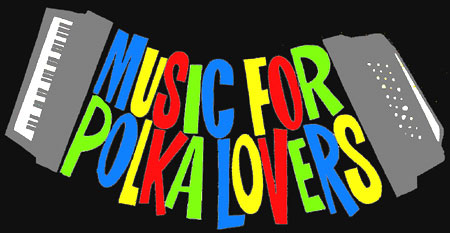
An early un-dated polka 78rpm record (top) and the logo from a 1960s polka album (bottom). Very early on, polka became associated with bright colors.
Polka took off in the ballrooms of Prague, and like so many other cultural phenomena, was picked up by the French. Paris was swept by polkamania throughout the mid-nineteenth century. Traditional ballerinas quickly switched to teaching polka, and the young men they attracted are often credited (or blamed) with shifting dance in France from being a rather elite and sophisticated endeavor to that of a more bawdy mating ritual. Parents forbade their daughters from going to dance halls, fearful that the frantic pace of polka would stimulate other urges. It’s hard to picture polka as the rock and roll of the nineteenth century, but in many ways it was.
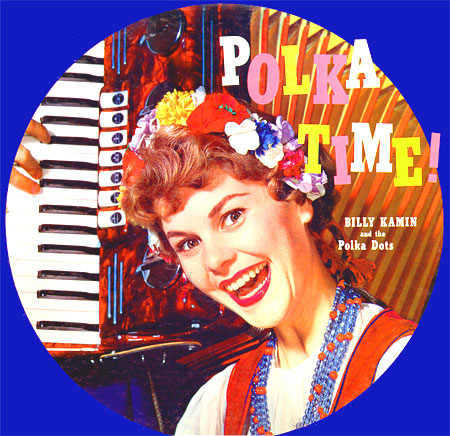

An undated polka album from Craftsmen Records (top) by Billy Kamin and the Polka Dots, and another undated record (bottom) from Promenade Records, featuring Stanley Polaski and his Orchestra. Both albums contain the perennial favorite, “Beer Barrel Polka.”
And because polka was a dance of the people, the instruments were often grass roots, too, which is why it has always been associated with the accordion (also a nineteenth-century phenomenon). Polish and Czech immigrants brought the dance and the music to America, where it took on nationalistic qualities and came to represent the “old country.”
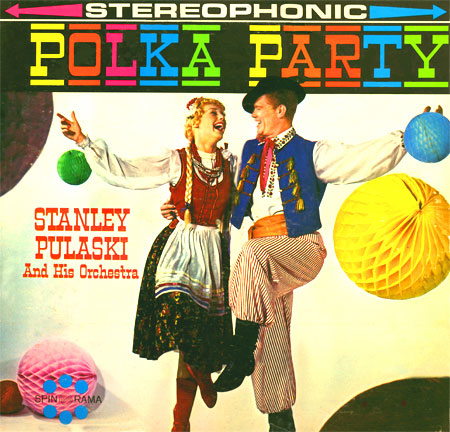
It’s a Polka Party with Stanley Pulaski and his Orchestra on the Spin-O-Rama label. Note the 3D polka dots.
What’s Dot?
Why the polka inspired the graphic pattern we know as polka dots is not well documented. Most sources say that during the early days of polkamania, all kinds of products were marketed under the polka banner, including polka hats, polka ties, and various items made of fabric with a “polka-dot” pattern.
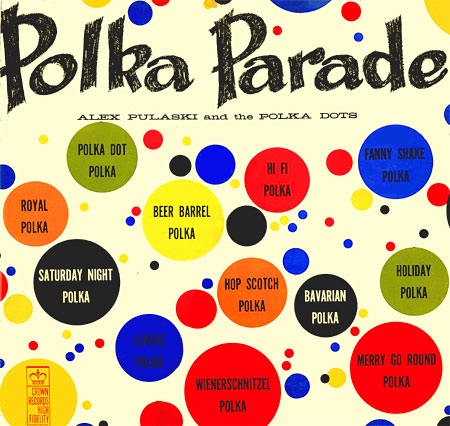
Almost all the polka records I own are undated and without copyright notice, which leads me to believe they were mostly fictitious groups brought together just to record the album. This time, it’s Alex Pulaski and the Polka Dots on Crown Records. My favorite song: “Wienerschnitzel Polka.”
Polka dots are generally defined as evenly spaced circles of the same size and same color. And while most polka-dot fabric is made this way, I like to think of polka dots as any pattern of brightly colored circles, used mostly as background. Polka dots no longer have any ties to polka music, though for a while many polka record albums were designed with a polka-dot pattern.
I love Polka style because, like so many other genres, it almost always deteriorates to a set of standard clichés. If you’re going to promote a waltz recording, you use some sort of flowing script typeface. For an album of John Phillip Souza marches, you drag out bold circus-like faces, and for Polka it seems the choice is either a heavy old-world serif, or a hand-drawn casual script. And because of its fast pace and short moniker, the word “polka” is often followed by an exclamation point, which is a punctuation mark I wholly support!
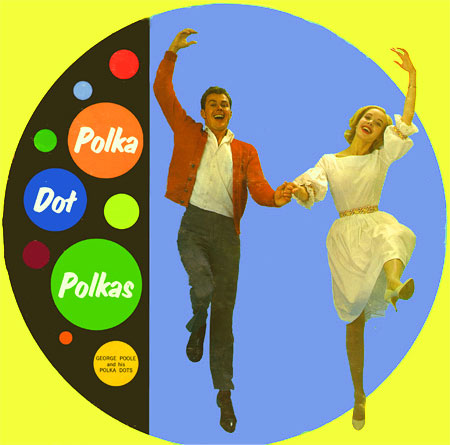
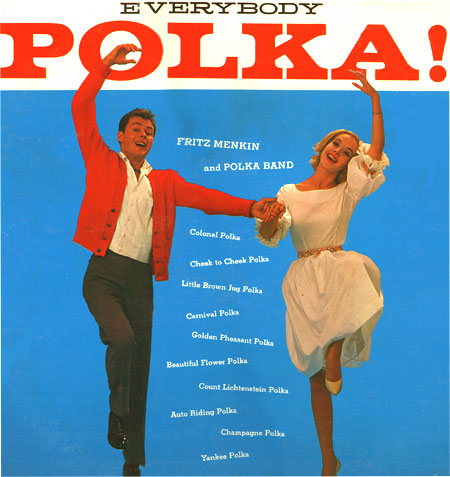
Two albums from two different record companies, but with the same happy dancing couple adorning each. Polka stock photography was apparently alive and well in the early 1960s when these records were released by Craftsman (top), also featuring a group called the Polka Dots, and Golden Tone (bottom), featuring Fritz Menkin and the Polka Band.
The graphic design element of polka comes and goes and is most associated with ’60s Mod style. But polka dots have inspired a number of logos, product design, and even architecture throughout the years. This is clearly a case where a term caught on as a description of something that had existed for a long time. Way before the mid-nineteenth century, patterns of repeating circles were used as graphic elements.

Supposedly, the inventor of Twister (top) was inspired by the polka-dot craze.
Long Live Polka — Dots
While polka music may not be a national mania anymore, you can find many polka festivals around the country each year. One of the major cruise-ship lines even offers an annual polka cruise. But it’s true that attempts at raising polka to hip status have failed, unless you count Weird Al Yankovic and the polka/rock group Brave Combo as “hip.”
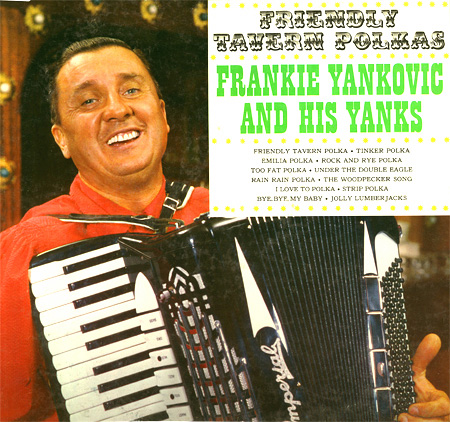
Weird Al Yankovic does play the accordion but is not related to the more famous Frank Yankovic, who died in 1988. He was the real Polka King and won the first Grammy given for polka. His polka albums sold in the millions during his long reign as America’s premiere polka artists. (Weird Al did, however, play on the song “Who Stole the Keeshka,” which appeared on a late Frankie Yankovic album.)
This year there were only 20 albums considered for a Grammy in the polka category — about half of previous years. Maybe that’s because in the 20 years they have been giving a Grammy for Polka, Jimmy Stur has won 15 times. So either polka continues to lose favor, or other polka artists have long given up.
I just hope the declining popularity of the music doesn’t reflect in a similar decline of the graphic art pattern.
Read more by Gene Gable.
This article was last modified on May 18, 2023
This article was first published on February 27, 2006




Hi Gene,
Thanks for the fine article on the polka. I’m an illustrator, but I’m also a musician. When In the late 1950’s, I was a lead guitarist in a polka band, “Johnny Woytaszek & The Thunderbay Polka Jax”. I had some great times and, while I didn’t appreciate that experience at the time, I sure do now. It is an infectious, good-time music and is vastly underrated.
-Elwood H. Smith
I know this article is about graphics, but you left out polka’s strong influence south of you. The spanish ‘Tejano’ music, which is very popular latin music, is a great mix of spanish music styles with the German accordion polka. The late Texas latin pop singer Selena (www.selena.org) sang mostly Tejano before her pop stardom. The most popular radio station in Texas is Tejano. So polka alone may be quite boring, but when you mix it with other flavors (graphically too), you get a great result.